Tofuku-ji temple

Tofuku-ji is famous for its brilliant colored leaves and is extremely crowded
in late November. The Rinzai-sect Buddhist temple has excellent modern
karesansui gardens that were laid out in 1939 by Shigemori Mirei (1896-1975). Its San-mon gate is the oldest of its kind and a national
treasure. The big Zen temple also has several structures that are important
cultural properties.
History
Kujo Michiie (1193-1252), the then most powerful statesman, started construction
of the biggest temple in Kyoto in 1236 to pray for the soul of his late
grandfather. He named the temple Tofuku-ji by taking kanji characters from
two great temples in Nara, namely Todai-ji and Kofuku-ji. The construction
was completed 19 years later in 1255. They asked successfully the Priest
Shoichi (En'ni Ben'nen, 1202-1280) to be the Founder in 1243.
Most of the buildings were reduced to ashes during successive fires in the years 1319, 1334 and 1336. Butsu-den (Buddha hall) was rebuilt in 1347.
In 1881, Hojo, Butsu-den, Hatto (a lecture hall of Zen sects) and Kuri
were destroyed by an accidental fire. Hojo and Kuri were rebuilt in the
year 1890 and 1910 respectively. They started to build Hondo that doubles
as Butsu-den and Hatto in 1917 and completed in 1934.
How to get to Tofuku-ji
2 minutes from Kyoto Station to Tofuku-ji station by JR Lines, then 10
minutes on foot.
11 minutes from Kyoto Station to Tofuku-ji bus stop by Kyoto City Bus 208,
then 10 minutes on foot.
5 minutes from Gion-Shijo station to Tofuku-ji station by Keihan Railway
line, then 10 minutes on foot.
7 minutes from Gion-Shijo station to Toba-Kaido station by Keihan Railway
line, then 5 minutes on foot.
Hours and Admission
All except November: 9:00-16:00 (reception will be closed at 15:30)
November: 8:30-16:30 (reception will be closed at 16:00)
Hojo is closed December 29 - January 3.
Admission for Tsuten-kyo and Kaisan-do/Fumon-in garden:
High school students and older: 400 yen
Junior high school students (7th - 9th graders) and younger: 300 yen
Admission for Hojo:
Same amounts as Tsuten-kyo.
Click on a photo for full image.
 |
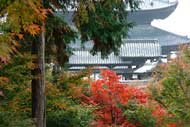 |
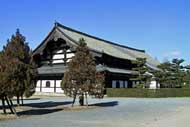 |
The oldest Sanmon gate of Zen temple in Japan and a national treasure.
The two storied gate was built sometime in Oei era (1394-1428). On the
second floor are figures of Buddha and his 16 disciples and a couple of
others. Inside of the second floor is painted colorfully. Closed to the
public except Mar. 14-16.
November 27, 2008 |
Hondo (Main Hall) looked from north. The construction of the big hall was completed in 1934 after 17 years of work. This single hall is used as both of Butsu-den and Hatto. The roof seen before Hondo is that of Hojo.
November 25, 2000 |
Zen-do hall which was rebuilt in 1347. This is the oldest and largest Zen
meditation dojo in Japan. An important cultural property.
January 16, 2001 |
 |
 |
 |
Kyozo, a storehouse for volumes of sutra and other important books.
November 27, 2008 |
Tosu, a lavatory. The oldest of this type and an important cultural property.
November 27, 2008 |
Kuri. This building is also an entrance for Hojo.
January 16, 2001 |
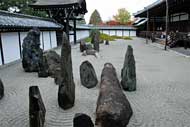 |
 |
 |
The southern garden in front of Hojo. One of four karesansui gardens around
Hojo building that were laid out by Shigemori Mirei. The four gardens are called Hasso-no-niwa collectively.
November 27, 2008 |
The southern garden of Hojo.
November 27, 2008 |
The southern garden of Hojo. Shigemori used exceptionally big stones as karesansui garden.
November 27, 2008 |
 |
 |
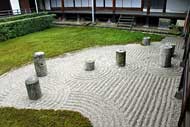 |
The southern garden of Hojo. At the west end of the garden are moss covered
low tsukiyama.
November 27, 2008 |
The western garden of Hojo, that is called Seiden-Ichimatsu.
November 27, 2008 |
The eastern garden of Hojo. Called Hokuto-Shichisei-no- niwa (Garden of the Big Dipper).
November 27, 2008 |
 |
 |
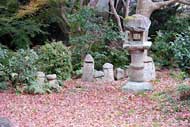 |
The northern garden of Hojo in autumn.
November 27, 2008 |
The northern garden of Hojo in winter.
January 16, 2001 |
Jizo and a stone lantern in the east of Hojo.
November 27, 2008 |
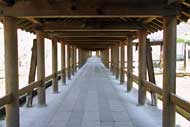 |
 |
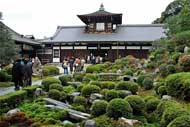 |
Inside of Tsuten-kyo bridge.
January 16, 2001 |
Colored leaves and a roofed passage.
November 27, 2008 |
Kaisan-do (Joraku-an), an important cultural property, and Chisen-shiki
teien (a pond garden)
November 27, 2008 |
 |
 |
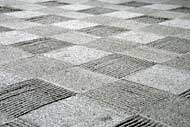 |
A pond garden in front of Kaisan-do.
November 27, 2008 |
Fallen leaves, one floating, another sunken in hexagonal tsukubai.
November 27, 2008 |
Karesansui garden in front of Kaisan-do
November 27, 2008 |
 |
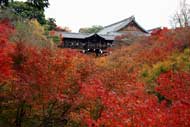 |
 |
A gate and Karesansui garden in front of Kaisan-do
November 27, 2008 |
Tsuten-kyo bridge looked from Gaun-kyo bridge.
November 27, 2008 |
Tsuten-kyo bridge looked from Sengyoku-kan ravine.
November 25, 2000 |
 |
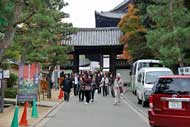 |
 |
A creek on the bottom of Sengyoku-kan.
November 25, 2000 |
Kusaka-mon gate
November 27, 2008 |
Gaun-kyo, a covered bridge. An important cultural property.
November 27, 2008 |



























